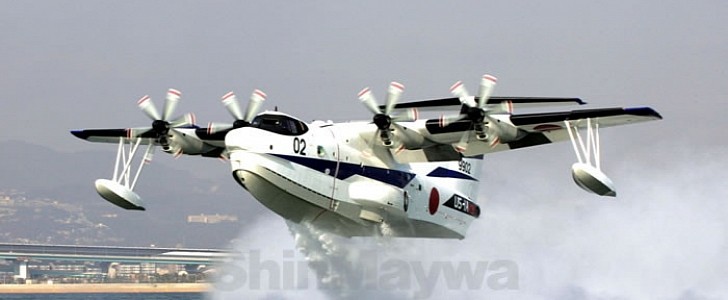This versatile aircraft combines the benefits of an amphibian (meaning that it can land on both ground and water) with those of a short take-off and landing (STOL) model. The result is an impressive aircraft that can land on the roughest seas, with waves of up to one-third of its height. And it uses this power for the best possible cause.
Known as the US-2, an upgraded version of its predecessor, the US-1, this amphibious STOL is currently in use with the Japan Maritime Self Defense Force (JMSDF) for search and rescue missions. All of its remarkable characteristics are put to good use when it comes to rescuing victims at sea or from remote islands.
First of all, it has a much wider range compared to a helicopter (which is commonly used for search and rescue missions) – and that is 4,700 km (2,920 miles) versus 850 km (528 miles). With a cruise speed of 480 kph (298 mph), it’s also faster than helicopters (260 kph/161 mph).
Perhaps the most crucial aspect is that it can access many more remote islands, compared to other types of aircraft, according to the studies performed by its manufacturer, Shinmaywa.
Designed with some of the most remarkable STOL capabilities in the world, the US-2 needs only one-fourth of the standard take-off and landing distance of commercial airliners. And, as an amphibian, it can do the same on the water, where it also requires only 280 meters (918 feet) for take-off and 330 meters (1,082 feet) for landing.
Of course, this also means it doesn’t need a runway, which makes it a great option for accessing remote areas.
This top-notch performance is due to the US-2 upgrades, which included a fly-by-wire (computer-controlled) flight system, a pressurized cabin, and new-generation high-powered engines (Rolls-Royce AE2100J).
The company that built both the US-1 and US-2 has a long tradition in manufacturing powerful aircraft, including ancestors of today’s amphibians. With the US-2, Shinmaywa considers that it has developed the best STOL amphibious in the world. Whether this is the case or not, the most important thing is that over 1,000 rescue operations were conducted so far by the two JMSDF amphibious aircraft.
First of all, it has a much wider range compared to a helicopter (which is commonly used for search and rescue missions) – and that is 4,700 km (2,920 miles) versus 850 km (528 miles). With a cruise speed of 480 kph (298 mph), it’s also faster than helicopters (260 kph/161 mph).
Perhaps the most crucial aspect is that it can access many more remote islands, compared to other types of aircraft, according to the studies performed by its manufacturer, Shinmaywa.
Designed with some of the most remarkable STOL capabilities in the world, the US-2 needs only one-fourth of the standard take-off and landing distance of commercial airliners. And, as an amphibian, it can do the same on the water, where it also requires only 280 meters (918 feet) for take-off and 330 meters (1,082 feet) for landing.
Of course, this also means it doesn’t need a runway, which makes it a great option for accessing remote areas.
This top-notch performance is due to the US-2 upgrades, which included a fly-by-wire (computer-controlled) flight system, a pressurized cabin, and new-generation high-powered engines (Rolls-Royce AE2100J).
The company that built both the US-1 and US-2 has a long tradition in manufacturing powerful aircraft, including ancestors of today’s amphibians. With the US-2, Shinmaywa considers that it has developed the best STOL amphibious in the world. Whether this is the case or not, the most important thing is that over 1,000 rescue operations were conducted so far by the two JMSDF amphibious aircraft.












